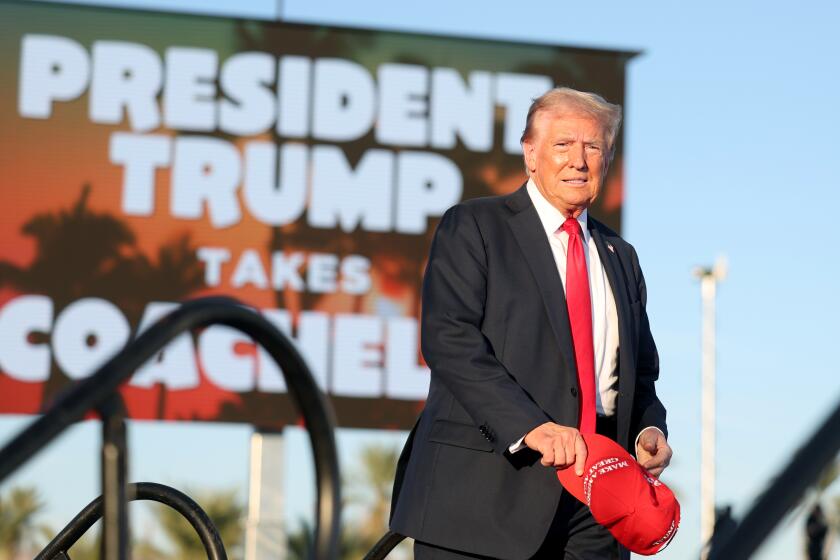Trade Paves Path to U.S. Prosperity
WASHINGTON — Trade policy has emerged as a point of differentiation among the presidential candidates this election year. The Democrats run the gamut, from “Yes we need free trade, but ... “ to nearly protectionist positions. Candidates have reasonably fretted about the fate of U.S. workers, about labor and environmental standards in other countries and about multinational companies bleeding local communities dry. Meanwhile, the Bush administration is doing an interesting trade tango of its own; signing accords and planning new rounds of negotiations but bogged down on a hemispheric Free Trade Area of the Americas agreement and using market-skewing steel tariffs and farm subsidies to provide perks to states crucial to the president’s reelection.
What is missing is common sense. Trade is neither the super-catalyst for economic growth that its supporters tout nor the destroyer of American jobs and Third World environments its opponents fear. It is an important and productive tool for promoting U.S. business expansion and international development, though it comes with strings attached.
Lots of people seem to like the idea of free trade -- of commerce, goods, services, capital and ideas flowing easily between countries. But they want it without any social or political costs. Getting past the overheated posturing, there are some fundamental truths about trade that seem to be conveniently pushed to the side by political leaders, policymakers and the media.
Blame productivity, not trade: Opponents love to say trade is why U.S. manufacturers and workers face tough times. But that’s not entirely true. Former Labor Secretary Robert B. Reich recently pointed out that manufacturing jobs are not simply leaving the U.S. for lower cost countries, they are disappearing all over the world. Since 1995 more than 22 million factory jobs have vanished, and the U.S. is not even the biggest loser: This country lost about 11% of its manufacturing jobs, but over the same period Japan lost 16%, China 15% and Brazil 20%. The reason is the higher productivity that comes with enhanced efficiency and new technology. After all, despite these lost factory jobs, global manufacturing output is up 30% over the past 10 years. And if there is one thing economists can agree on it’s that productivity growth is good across the board.
Free trade creates more winners than losers: About 500,000 people in the U.S. have lost jobs to lower wage Mexico because of the North American Free Trade Agreement. Any attempt to diminish this painful reality is unfair and unwise. But in the 10 years since President Clinton signed NAFTA with bipartisan support, U.S. private-sector employment has grown by 15 million jobs whose hourly wages are up 10%. And families now save $2,000 each year from lower consumer costs. Trade definitely catalyzes positive economic factors as well as negative side effects that deserve attention and action. But would anyone suggest the loss of a half million jobs to spur the economic activity that added millions at higher wages is not an acceptable price to pay?
Change is disruptive, even if positive: The job creation/job loss churn is the very nature of the U.S. economy and the free-market system. Consider a point made by Tom Peters in his recently published book “Re-imagine!” Between 1980 and 1998, the U.S. economy produced 29 million net new jobs while Europe, with one-third again more people, gained just 4 million. The Americans created so many more new jobs, Peters suggests, because they had “the nerve to destroy 44 million jobs. At Sears. At Chrysler. At AT&T.; At IBM. Then we offset those lost jobs with 73 million new jobs. At Microsoft. At Dell. At CNN. At Genentech.” Though a bit Darwinian, the truth is that change, including that driven by trade and market-opening, delivers gains that outweigh losses.
The costs of closed markets: Barriers to trade impose an indirect tax on consumers, who pay more for products that don’t face the free-market competition that keeps costs down and rewards efficiency. One example: A decade ago the U.S. luggage industry fought to keep foreign-made suitcases and bags from store shelves in this country, avoiding competition and saving jobs but costing U.S. consumers more than $1 million in out-of-pocket expenses for each job -- about $300 million in costs imposed on them to protect about 250 jobs. In November, Federal Reserve Chairman Alan Greenspan warned that just this sort of “creeping protectionism” was finding footing in the U.S., an anathema to the country’s free-market ideals.
The really big picture: No nation has ever sustained long-term economic growth without participating aggressively in trade. East Asia has lifted 300 million people out of poverty in the past 30 years almost exclusively through exporting, importing and international commerce. The International Monetary Fund and the World Bank have endorsed the theory that countries open to trade grow faster than those with closed markets, with the benefits directly accruing to the poor -- a 1% increase in GDP reduces poverty by 1.5%, and further trade reforms could lift 140 million people out of poverty in the next 15 years. This means many more communities in Latin America, Asia, the Middle East and Africa will one day be middle class and eager to drink Pepsi, wear Levi’s, Instant Message on AOL, get their Bruce Springsteen CDs from Amazon delivered by UPS and read Rolling Stone magazine at their neighborhood Starbucks. In short, they’ll be U.S. consumers adding to the U.S. bottom line even if they don’t live here.
Even with trade’s job creation, higher wages and lower prices, what is missing is a far-reaching plan to ease the pain of those who do lose out -- real families facing real anxiety thrown into real pain and financial crisis. The answer is not protectionism but making each American always employable and education and retraining easily and conveniently available.
When trade takes the political center stage this year, the conversation should be pushed to ideas about wage insurance that protects workers from pay cuts if their jobs are lost to trade, incentives for employers to offer education opportunities to workers, and investments in technology, infrastructure and skills so that keeping jobs in the U.S. is a business advantage. The trade policy playbook can be a short one: keeping the U.S. thriving in the global economy, accepting responsibility for those dislocated and lending them a helping hand, and investing in ourselves so that we prosper amid the next waves of competition.
More to Read
Get the L.A. Times Politics newsletter
Deeply reported insights into legislation, politics and policy from Sacramento, Washington and beyond. In your inbox three times per week.
You may occasionally receive promotional content from the Los Angeles Times.










